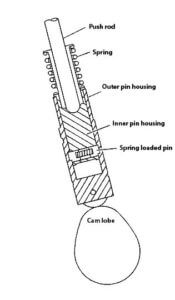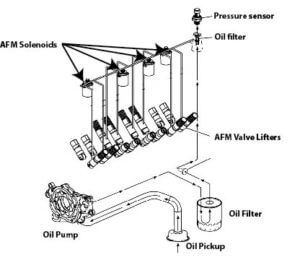Disable Active Fuel Management
Should you delete Active Fuel Management on GM engine?
Read this before you delete active fuel management cylinder deactivation
There are two ways to disable active fuel management on a GM vehicle, but first you have to determine whether your engine is a candidate for the delete or disable procedure. Before you go there, you must first understand how the system works, because performing a disable on an engine with worn active fuel management components may cause additional damage.
How active fuel management works
GM’s Active Fuel Management (AFM) works under certain light load driving conditions to maximize fuel economy by deactivating 4 of the engines 8 cylinders. The engine will operate on 8 cylinders in V8 mode during starting, idling, and medium or heavy throttle conditions. When commanded ON, the engine control module (ECM) commands the AFM system to deactivate cylinders 1 and 7 on the left bank and cylinders 4 and 6 on the right bank.
The valve lifters in these engines are fitted with  spring loaded locking pins that connect the internal pin housing of the lifter to the outer housing. The housing contains a plunger that works with the pushrod. The housing contacts the camshaft lobe with a roller.
spring loaded locking pins that connect the internal pin housing of the lifter to the outer housing. The housing contains a plunger that works with the pushrod. The housing contacts the camshaft lobe with a roller.
During full V8 operation, the locking pins lock the pin housing and outer housing together so the AFM lifter work like and ordinary valve lifter. When the ECM commands the V4 mode, the locking pins are pushed forward from oil pressure from the valve lifter oil manifold (VLOM) assembly solenoids. That unlocks the pin housing from the outer housing. The outer housing moves with the cam profile while the pin housing remains stationary and does not operate the push rod.
The intake and exhaust valves aren’t deactivated at the same time. The ECM times cylinder deactivation on an intake stroke when the intake cam lobe is pushing the valve lifter up to open the intake valve against the force of the valve spring. The force exerted by the valve spring is acting on the side of the lifter locking pins, preventing them from moving until the intake valve has closed. When cylinder deactivation is commanded ON, the exhaust valve for the deactivated cylinder is in the closed position, allowing the locking pins on the valve lifter to move immediately, and deactivate the exhaust valve.
Deactivating the exhaust valve first allows the capture of a burnt air/fuel charge or exhaust gas charge in the combustion chamber. The capture of exhaust gases in the combustion chamber contributes to a reduction in oil consumption, noise and vibration levels, and exhaust emissions when operating in V4 mode.
During the transition from V8 to V4 mode, the ECM turns the fuel injectors OFF on the deactivated cylinders. However, the ignition system still provides high secondary voltage to the spark plugs and the spark still jumps the gap on the deactivated cylinders.
How the Active Fuel Management oil circuit works
A valve lifter oil manifold assembly is bolted to the top of the engine block beneath the intake manifold. The oil manifold consists of 4 solenoids that are closed until activated by the ECM. Each solenoid allows pressurized oil to flow to the AFM valve lifters. The system also includes an oil pressure relief valve in the oil pan to regulate engine oil pressure to the engine lubrication system and the oil manifold.
Power is provided to each of the four solenoids  when the engine is running. When the ECM activates AFM, the ECM provides the ground connection to each solenoid in proper firing order sequence. The solenoid valves open, allowing pressurized oil into valve lifter oil manifold and into 8 vertical passages in the engine block lifter valley and to the valve lifter bores of the cylinders to be deactivated. When the ECM turns off the V4 mode, the ground connection is disabled and the solenoid valves. The remaining oil pressure is exhausts through the bleed passages of the valve lifter oil manifold and into the engine block lifter valley. The housing of the oil manifold incorporates several oil bleed passages that continually purge trapped air from the manifold and engine block.
when the engine is running. When the ECM activates AFM, the ECM provides the ground connection to each solenoid in proper firing order sequence. The solenoid valves open, allowing pressurized oil into valve lifter oil manifold and into 8 vertical passages in the engine block lifter valley and to the valve lifter bores of the cylinders to be deactivated. When the ECM turns off the V4 mode, the ground connection is disabled and the solenoid valves. The remaining oil pressure is exhausts through the bleed passages of the valve lifter oil manifold and into the engine block lifter valley. The housing of the oil manifold incorporates several oil bleed passages that continually purge trapped air from the manifold and engine block.
To help control contamination within the active fuel management hydraulic system, a small replaceable oil filter is located in the valve lifter oil manifold oil inlet passage. The oil pressure sensor monitors engine oil pressure and provides information to the ECM.
Here’s why you have to cautious about disabling active fuel management disable kit
First, if an AFM valve lifter has failed or is starting to fail, you are NOT a candidate for an active fuel management disable fix. What causes AFM valve lifters to fail:
• Using the wrong motor oil
• Neglecting oil changes
• Not using the proper oil filter or changing it often enough.
In other words, you’ve already caused some engine damage. When you add an AFM delete kit, the oil is no longer allowed to flow through the solenoids. So all the excess oil pressure is dumped back into the oil sump, which can cause it to spray on the cylinder walls during normal engine operation. That will result in a dramatic increase in oil consumption because the oil rings will pull excess oil into the cylinder. The excess oil will cause spark plug fouling, poor performance, and damage to your catalytic converter. It will also cause you to fail emissions testing.
If you have AFM lifter failure, either replace the AFM lifters with new units OR, install an AFM delete kit. Do NOT install an AFM disable device!
What’s in an AFM delete kit?
You may think an AFM delete kit saves you money. Because the cam lobes for the AFM cylinders are ground differently you must replace the camshafts with new camshafts from the delete kit. You also have to replace the high volume oil pump with a traditional oil pump, and you have to replace ALL the valve lifters. Plus, you’ll also have to reprogram the ECM with AFM delete software. In addition to working on the top of the engine, you should also remove the oil pan and plug the pressure relief valve in the oil pan. In other words, performing an AFM delete will NOT save you money over simply replacing the AFM valve lifters with new units. It will also cost you the 5-7% fuel savings that AFM provided.
How does an AFM disable kit work?
The AFM Disabler plugs into your OBD-II port. It prevents the computer from switching over to four-cylinder mode. It will also cost you the 5-7% fuel savings that AFM provided.
©, Rick Muscoplat
Posted on by Rick Muscoplat
